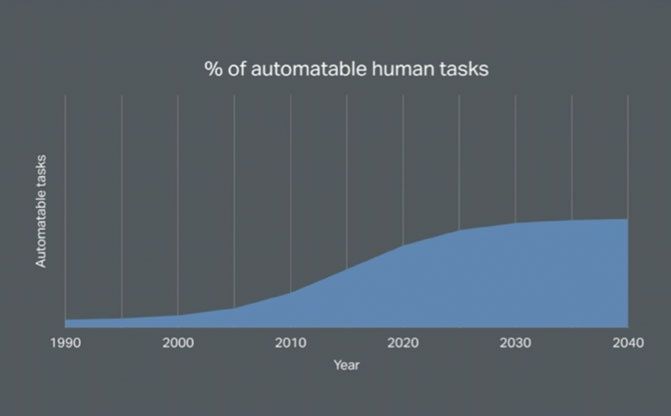
Would this mean in the emerging technology fields of artificial intelligence (AI) and robotics engineering rather than on the rust-belt manufacturing jobs of the pre-1980s era? “We’ve worked closely with SoftBank for many years and we believe their new fund will speed the development of technologies which may be strategically important to Apple,” Josh Rosenstock, an Apple spokesman said.
Apple’s CEO Tim Cook told CNBC it was already negotiating with one particular company about the fund and said the investment was planned to spur other firms in the Silicon Valley area to expand their workforces.
“By doing that, we can be the ripple in the pond,” he said.
“Because, if we can create many manufacturing jobs … those manufacturing jobs create more jobs around them because you have a service industry that builds up around them.”

But what is AI and how far in the technology world is the field of with robotics? Both AI and robotics are computer-science related sectors concerned with intelligent machines that can “think” and work like humans. Some of the key areas they are designed to master are:
- Speech recognition
- Learning
- Planning
- Problem solving
Computer scientists are experimenting with programmes to develop their artificial intelligence in:
- Knowledge
- Reasoning
- Problem solving
- Perception
- Learning
- Planning
- Ability to manipulate and move objects
 https://www.youtube.com/watch?v=xenOYWVwkGY
https://www.youtube.com/watch?v=xenOYWVwkGY
Machines have not yet taken over our everyday lives but aspects of AI and robotics are already present in some of the things we do. Voice-activated phone assistants such as an iPhone’s Siri and Amazon’s Alexa or Microsoft’s Cortana to driverless cars are some of the technologies that rely on AI use.
One example of a truly AI system is Google’s DeepMind which can learn on its own rather than being programmed with algorithms. Recently its AlphaGo beat the world’s number one 19-year-old human Go Player Ke Jie from China (it’s a 3-000-year-old Oriental board game) in the first round of a three-part match.

https://www.theverge.com/2017/5/23/15679110/go-alphago-ke-jie-match-google-deepmind-ai-2017
But machine learning is already incorporated into many everyday aspects of our lives. Here are some examples:
- Speech recognition. Skype Translator now supports Arabic, English, French, German, Italian, Mandarin, Brazilian Portuguese, and Spanish.
- Sales forecasting. Conversion management using inbound communication. Much like predictive customer service, inbound emails can be analysed and action taken based on past behaviours and conversions.
- Image recognition. Google Photos allows you to search your photos for ‘cats’. Facebook recognises faces, as does Snapchat Face Swap.
- Content generation. Content generation is chiefly done using structured data. Wordsmith is a platform that allows the automatic generation of news articles, for example, from financial reports. However the plan is to do this sort of content generation with unstructured data.
- Bots, PAs and messengers. Chatbots are thought by many to be the future of user input on mobile, replacing apps. Simply talking or typing to a chatbot will allow a service to be delivered through the analysis of natural language combined with an understanding of a brand’s datasets.
- Recommendations and content curation eg Netflix or Amazon. Their algorithms are continually being improved to aid suggestions and recommendations for their users.
- Search engines. People have been using these without realising the power of their AI for years.
- Preventing fraud and data breaches
- Analysing credit/debit card usage patterns and device access allows security specialists to identify points of compromise.

https://www.ted.com/talks/anthony_goldbloom_the_jobs_we_ll_lose_to_machines_and_the_ones_we_won_t#t-193025
The future of AI and robotics scares many people as some experts warn that humans will be in even less demand for jobs than machines. In the Scientific American Massachusetts Institute of Technology economist Erik Brynjolfsson in his book with book Race against the Machine written with MIT’s Andrew McAfee argues that there will be three sets of winners and losers in the machine age:
“The first is skilled versus less skilled workers, as a result of what’s called skill-biased technical change. As technology advances, educated workers tend to benefit more and workers with less education tend to have their jobs automated. It’s not a perfect correlation but there is a correlation.”
“The second is called capital-biased technical change. The share of income going to capital owners has grown relative to the share of income going to labor providers….The third change might be the most important one: It’s called superstar-biased technical change, or talent-biased technical change. If somebody has talent or luck in creating something that people want, that thing can be replicated with digital technology much more easily than in the past.”

Education and especially computer science education is, as Brynjolfsson says, the only way to go. This Autumn MIUC will be introducing a new BSc in Computer Science……
https://miuc.org/academic/undergraduate/bsc-information-systems-data-science/
https://miuc.org/academic/postgraduate/msc-business-analytics-big-data/
By Mary O’Carroll
